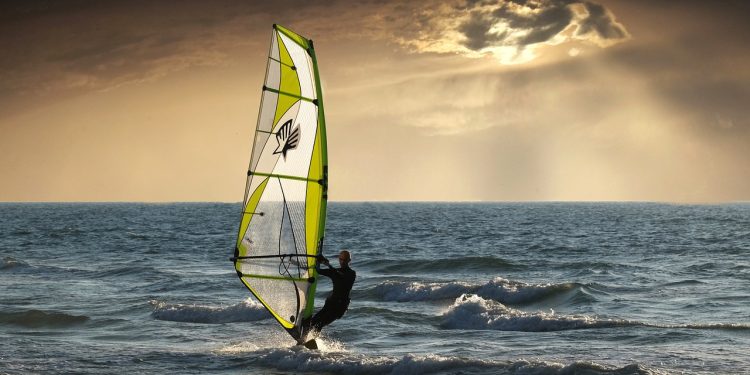Windsurfing is one of the most exciting water sports, offering an exhilarating combination of sailing and surfing. It combines the thrill of riding waves with the challenge of harnessing wind power, and mastering this unique sport is as much about technique as it is about experience. Whether you’re a beginner looking to improve your basic skills or an intermediate windsurfer aiming to advance to more challenging conditions, there are always ways to improve. Here are some valuable tips to help you become a better windsurfer and enhance your time on the water.
1. Master the Basics First
Before attempting any advanced maneuvers or tackling challenging conditions, it’s essential to have a solid grasp of the basics. Make sure you’re comfortable with essential skills like uphauling (pulling the sail out of the water), balancing on the board, tacking (turning the board into the wind), and jibing (turning away from the wind). Taking the time to master these foundational skills will make your progression much smoother.
When you feel confident with the basics, practice them repeatedly until they become second nature. The goal is to achieve a level of comfort where you don’t have to think consciously about each movement—this will free up your focus for more advanced skills later on.
2. Learn to Read the Wind
Understanding the wind is crucial in windsurfing. Learn to read the water’s surface for cues about the wind’s speed and direction. Darker patches on the water often indicate stronger wind, while ripples and waves reveal its direction. Spending time simply observing the conditions before heading out can significantly enhance your performance.
A good windsurfer knows how to anticipate changes in wind speed and direction, adjusting their body position and sail accordingly. Practice looking upwind, not just at the water around you, to better predict gusts or lulls before they reach you. This ability to foresee changes in the wind will allow you to react proactively rather than reactively, improving your stability and control.
3. Use the Harness Effectively
Using a harness can significantly reduce fatigue and improve your control, allowing you to stay out on the water longer. The harness transfers the pull of the sail from your arms to your core, reducing the physical strain on your arms and shoulders. Learning how to properly hook in and out of the harness is crucial to improving both your comfort and your efficiency on the board.
To get started, practice hooking in while sailing in moderate wind conditions. Lean back into the harness and let your body weight do the work of counterbalancing the sail. Keep your arms slightly bent and relaxed, which will help you avoid tensing up and getting exhausted too quickly. Once you’re comfortable, the harness will become one of your most useful tools, giving you more power and allowing you to windsurf longer without tiring out.
4. Focus on Your Stance and Balance
Your stance on the board is a major factor in windsurfing success. A proper stance keeps your center of gravity low and stable, improving your balance and control. Keep your knees bent and weight centered over the board. Try to shift your weight onto your back foot when you need more control over the board’s direction, and distribute it more evenly for a faster glide.
Your body position should be dynamic, constantly adjusting in response to the wind and water conditions. Keep your core engaged to maintain stability and resist the pull of the sail. A relaxed but strong posture will allow you to respond quickly to gusts of wind and choppy water. Remember, balance is not static—it’s about constantly making small adjustments to stay in control.
5. Use Your Bodyweight to Steer
One of the most effective ways to steer a windsurfing board is by using your bodyweight. Shifting your weight forward and backward on the board will help you accelerate, decelerate, and change direction. Leaning back slightly can help you point upwind, while shifting your weight forward can help you bear away from the wind.
Another important steering tip is to use the mast and sail position to direct the board. Pulling the sail towards you will cause the board to steer upwind, while pushing it away will steer it downwind. Experimenting with weight shifts and sail angles in different conditions will help you better understand how to maneuver effectively.
6. Practice Waterstarts
Learning to waterstart is a major milestone for windsurfers, allowing you to get back on the board without having to uphaul the sail. It is a more efficient way to get moving again, especially in deeper water or when you’re dealing with larger sails. To perform a waterstart, position the sail so that it catches the wind, use your arms and core to lift yourself onto the board, and let the power of the wind do the rest.
Practice waterstarts in a variety of wind conditions, starting with lighter wind to get a feel for positioning the sail and finding balance. This skill will not only save you energy but also improve your confidence when tackling larger swells and stronger winds. The key is to keep the sail under control and position yourself in a way that allows you to use the wind’s power efficiently.
7. Improve Your Footwork
Footwork is a fundamental part of progressing in windsurfing. Smooth transitions, tacks, and jibes all depend on good foot placement. Practice moving your feet quickly and precisely when tacking or jibing. It helps to break down the movements on land first so that you can develop muscle memory.
A common beginner mistake is looking down at your feet, which throws off your balance and slows down your transition. Instead, keep your eyes looking forward or upwind, and feel your way into the footstraps. Quick and confident foot movements will make your transitions much more fluid and less likely to end in a fall.
8. Master the Carve Jibe
The carve jibe is one of the most impressive maneuvers in windsurfing and a key step in advancing your skills. It involves turning downwind while maintaining speed and control—a move that looks effortless when done correctly. The carve jibe requires a combination of board control, footwork, and balance.
Start by gaining some speed, and then lean into the turn by placing more weight on your back foot. Shift the sail across the front of your body as you come around the turn, and reposition your feet to maintain balance. Practicing the carve jibe repeatedly, even if it means falling a few times, will help you become more comfortable with maintaining speed while executing turns.
9. Ride in Different Conditions
The best way to improve as a windsurfer is to challenge yourself in a variety of conditions. Don’t limit yourself to practicing only in calm waters or light winds. Gradually expose yourself to stronger winds, choppier waters, and different environments. Each new condition presents a learning opportunity—whether it’s learning to maintain control during gusty winds or navigating waves.
Pushing yourself outside of your comfort zone will improve your adaptability, and you’ll gain a better understanding of how to adjust your stance, sail position, and weight distribution depending on the conditions. Of course, make sure you’re confident in your self-rescue techniques and don’t take unnecessary risks, but don’t shy away from a challenge either.
10. Watch and Learn from Others
One of the most effective ways to improve your windsurfing skills is to learn from others. Watching experienced windsurfers can provide valuable insights into technique, stance, and timing. Pay attention to their body positions, how they handle the sail, and how they react to changes in wind and water conditions.
If possible, take lessons from a qualified instructor who can provide personalized feedback and help correct any mistakes in your technique. Joining a windsurfing community or club can also be highly beneficial, as it gives you the chance to learn from others, practice together, and even participate in group challenges that push your skills further.
11. Stay Fit Off the Water
Windsurfing is physically demanding, requiring strength, stamina, and flexibility. Maintaining a good fitness level off the water will have a significant impact on your performance. Focus on exercises that build core strength, as a strong core is key to balance and control. Activities like yoga and Pilates can help improve your flexibility, while strength training and cardiovascular exercises will boost your endurance and power.
Exercises such as squats, lunges, and pull-ups are particularly beneficial for windsurfing, as they target the muscles used during sailing. Being in good physical condition will not only enhance your windsurfing skills but also reduce the risk of injury, especially when pushing yourself in challenging conditions.
12. Stay Patient and Have Fun
Windsurfing is a sport that requires time and patience. The learning curve can be steep, and there will be moments of frustration, especially when trying to master new skills. Stay patient with yourself and remember that every session on the water is an opportunity to learn something new—whether it’s a successful new maneuver or simply understanding what doesn’t work.
Most importantly, remember to have fun. Windsurfing is about enjoying the water, the wind, and the thrill of the ride. Celebrate small victories, embrace the falls, and keep a positive attitude. The more you enjoy the process, the more motivated you’ll be to keep improving, and the better windsurfer you’ll become.






